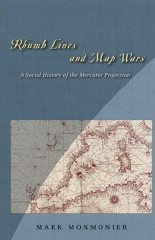Review: Rhumb Lines and Map Wars
Rhumb Lines and Map Wars: A Social History of the Mercator Projection
by Mark Monmonier
University of Chicago Press, 2004. Hardcover, 238 pp. ISBN 0-226-53431-6
 Rhumb Lines and Map Wars is Mark Monmonier’s response to the controversy over the Mercator projection stirred up by Arno Peters and his map that purported to be fair to all peoples. Rather than retroactively mixing it up with Peters and his chief critic, Arthur Robinson, Monmonier has taken a step or two back to create a broader understanding of Mercator, his projection and its uses.
Rhumb Lines and Map Wars is Mark Monmonier’s response to the controversy over the Mercator projection stirred up by Arno Peters and his map that purported to be fair to all peoples. Rather than retroactively mixing it up with Peters and his chief critic, Arthur Robinson, Monmonier has taken a step or two back to create a broader understanding of Mercator, his projection and its uses.
Most of us with some knowledge of map projections know that Mercator’s intent was to provide a map usable in sea navigation: angles on the map match constant compass lines. Monmonier reveals that Mercator was a little ahead of his time: it took centuries before the technology (such as chronometers) was developed to make his map one of several essential navigation tools. From the development of sailing charts to the development of Mercator variants such as the transverse and space oblique, Monmonier not only demonstrates the Mercator’s specific uses, but also that the projection was the result of divers hands. Mercator himself rates only a chapter; the map cannot be reduced to the mapmaker.
The source of the controversy over the Mercator projection was its use as a wall map; the Mercator’s dominance began during the 19th century, when ships were king. But by the 20th century its influence was beginning to wane. Other projections began making their appearance in atlases, such as Goode’s homolosine and the Mollweide. National Geographic had been using the compromise Van der Grinten projection on its wall maps since 1922. And, with the advent of aviation and beacon-based navigation, great circles became more important than rhumb lines.
Peters’s attack on the Mercator projection in the 1970s seems a bit odd in this context, which I think is Monmonier’s point. Apart from honking off academic cartographers, Peters proferred a solution that was hardly novel — there are plenty of equal-area equatorial projections out there, which differ only in their secants. But he was able to engage the imaginations of a number of organizations who were receptive to his post-colonial critique.
Monmonier finishes by questioning whether scholars exaggerate the influence of the Mercator projection on social thought: “Did Europe’s rulers and merchants need wall maps or world atlases to justify their actions? Did maps that inflated the size of the British Empire stifle whatever remorse nineteenth-century Britons might have had about racism and economic slavery in Africa or India? More to the point, did anyone ever die because of the Mercator projection?” But critics of the Peters projection don’t get off easy: “Although superior projections abound, the evils of the Peters maps are easily exaggerated. Do its users really think Africa looks that way? Do they never look at a globe, or at other maps? Are map users complete idiots?” (pp. 174-75)
Worth reading for Monmonier’s take on the Peters controversy alone, Rhumb Lines is a fine look at an influential, useful and maligned projection.
- Buy Rhumb Lines and Map Wars at Amazon.com

Comments
blog comments powered by Disqus